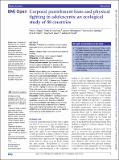Corporal punishment bans and physical fighting in adolescents : an ecological study of 88 countries
Abstract
Objective: To examine the association between corporal punishment bans and youth violence at an international level. Design: Ecological study of low-income to high-income 88 countries. Setting: School-based health surveys of students. Participants: 403 604 adolescents. Interventions: National corporal punishment bans. Primary outcome measure: Age-standardised prevalence of frequent physical fighting (ie, 4+ episodes in the previous year) for male and female adolescents in each country. Results: Frequent fighting was more common in males (9.9%, 95% CI 9.1% to 10.7%) than females (2.8%, 95% CI 2.5% to 3.1%) and varied widely between countries, from 0.9% (95% CI 0.8% to 0.9%) in Costa Rican females to 34.8% (95% CI 34.7 to 35.0) in Samoan males. Compared with 20 countries with no ban, the group of 30 countries with full bans (in schools and in the home) experienced 69% the rate of fighting in males and 42% in females. Thirty-eight countries with partial bans (in schools but not in the home) experienced less fighting in females only (56% the rate found in countries without bans). Conclusions: Country prohibition of corporal punishment is associated with less youth violence. Whether bans precipitated changes in child discipline or reflected a social milieu that inhibits youth violence remains unclear due to the study design and data limitations. However, these results support the hypothesis that societies that prohibit the use of corporal punishment are less violent for youth to grow up in than societies that have not.
Citation
Elgar , F J , Donnelly , P D , Michaelson , V , Gariépy , G , Riehm , K E , Walsh , S D & Pickett , W 2018 , ' Corporal punishment bans and physical fighting in adolescents : an ecological study of 88 countries ' , BMJ Open , vol. 8 , no. 9 , e021616 . https://doi.org/10.1136/bmjopen-2018-021616
Publication
BMJ Open
Status
Peer reviewed
ISSN
2044-6055Type
Journal article
Description
Funding: This work was supported by grants from the Canadian Institutes for Health Research (CIHR; grant numbers MOP133519, MOP341188), Social Sciences and Humanities Research Council (grant number 435-2014-2160) and Canada Research Chairs programme.Collections
Items in the St Andrews Research Repository are protected by copyright, with all rights reserved, unless otherwise indicated.

